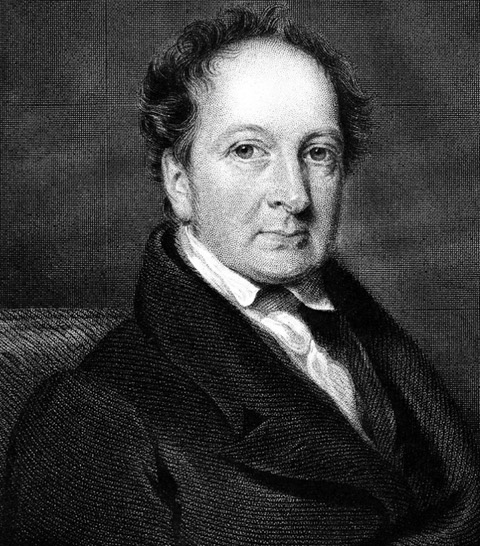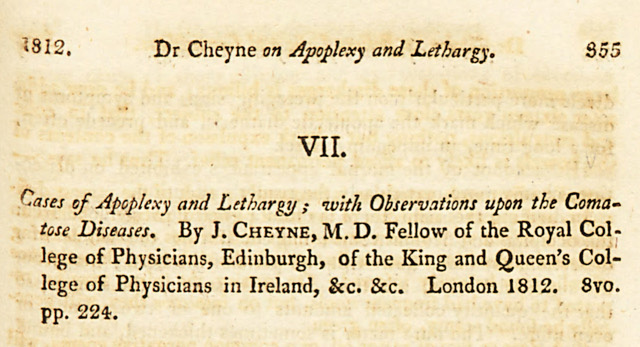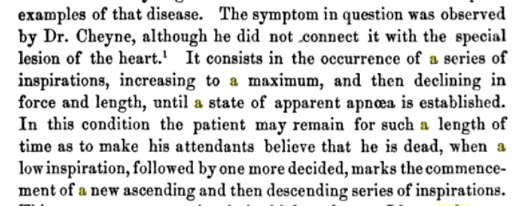
The fine scholar-physicians of the 17th and 18th centuries, who included Robert Whytt, John Cheyne, Thomas Sydenham and Thomas Willis, made meagre distinction between physical and emotional symptoms. They recognised both but viewed them as essential manifestations of nervous disorders. One ominous physical sign first recognised by John Cheyne was of abnormal breathing: Cheyne-Stokes respiration. It bears the eponyms of Cheyne and William Stokes who gave a later account (q.v.).
Physicians who care for emergencies frequently encounter Cheyne-Stokes respiration: abnormal breathing, in which cycles of apnoea alternate with series of gradually increasing depth and frequency of breathing. It is often sinister.
In 1818, John Cheyne (Figure 1) described a sixty-year-old man, a sufferer from gout who complained of palpitations and pain in the chest and had fallen from a chair but could not remember doing so. He found:
An extremely irregular and unequal pulse on examination, and the patient was confused and had headache. Following blood letting and the use of leeches, he improved. On the 10th of April he was found in bed, speechless, and hemiplegiac… The only peculiarity in the last period of his illness, which lasted eight or nine days, was in the state of the respiration. For several days, his breathing was irregular; it would cease for a quarter of a minute, then it would become perceptible, though very low, then by degrees it became heaving and quick, and then it would gradually cease again. This revolution in the state of his breathing occupied about a minute, during which there were about thirty acts of respiration [1].
He diagnosed apoplexy “that must have depended upon increased action of the vessels of the head.” At post mortem was found a left cerebral infarct. The heart was three times larger than normal, the left ventricle greatly enlarged, the right ventricle converted into a soft fatty substance…Aorta steatomatous.
John Cheyne (1777-1836) was the son of a surgeon. He is not to be confused with his namesake George Cheyne (1671-1743) who in 1733 composed a famous volume, The English Malady, which related to Nervous Distempers, Vapours, and Lowness of Spirits, then widely considered hysteria.

At the age of thirteen, John Cheyne began to attend to his father’s poor patients. He had to supply them with medicines, to bleed them, and to dress their wounds; thus he acquired an early familiarity with diseases. He graduated in medicine at the remarkably early age of eighteen at Edinburgh [2]. Alexander Monro secundus (1733-1817), who described the interventricular foramen, was one of his tutors, and Charles Bell taught him pathology and dissection. After four years of military service, he practiced with his father in Leith from 1799.
In 1809 he moved to Dublin where he was appointed physician to the Meath Hospital and Professor of Medicine at the College of Surgeons. He subsequently became Physician-General in the Irish army in 1820, the highest medical ranking in Ireland. He was a founder of the Dublin Hospital Reports. He wrote books on the croup, and Essays on Diseases of Children. In An essay on hydrocephalus acutus, or dropsy in the brain (1808), he recorded 23 cases; all but six succumbed: the suspected cause was tuberculous meningitis. In Cases of Apoplexy and Lethargy: With Observations Upon the Comatose Diseases (1812) (Figure 2), he distinguished subarachnoid from intracerebral haemorrhage, probably the first physician to provide an illustration of subarachnoid hemorrhage:
For the most part, extravasated blood is found within the cranium, sometimes between the membranes, sometimes in the substance of the brain. [my emphasis]

Another of his most important works was considered that on the typhus epidemics which ravaged Ireland. Pettigrew’s Biographical Memoirs (1839) provided a lucid, detailed account of his medical life [3].
Cheyne was elected a Fellow of the Royal Society of Edinburgh in 1814. After a distinguished and productive career, ill health caused his return to England, where he settled on a country estate in Sherrington, near Newport-Pagnell, Buckinghamshire in 1831. His last book, Essays on Partial Derangement of the Mind was published in 1843, seven years after his death in 1836 — perhaps an abreaction from his own late-life depression. The cause of death was ‘Mortification of the Lower Body’. A modest, diffident, and religious man he left detailed instructions for his burial:
My funeral must be as inexpensive as possible: let there be no attempt at a funeral sermon. I would pass away without notice from a world which, with all its pretensions, is empty.
A large stone monument (Figure 3) commemorates him.

Thirty-six years after Cheyne’s account, the illustrious William Stokes (1804-1878) [4] in one of many highly regarded texts acknowledged Cheyne’s earlier account [5]. Stokes’s father had succeeded Cheyne as Professor of Medicine and was a friend of Robert Graves, René Laennec, and the young Oscar Wilde [6]. William Stokes described a disorder of the pattern of respiration, not caused by a lung condition, but by an enfeebled heart, due to fatty degeneration of this organ or other causes [7]. “This symptom…I have only seen during a few weeks previous to the death of the patient…” [7].
Stokes noted disease of the aortic valve was common. He is also renowned for his account of Stokes-Adams attacks [8].
References
- Cheyne J. A case of apoplexy in which the fleshy part of the heart was converted into fat. Dublin Hosp Reports 1818;2:216-23.
- Lyons JB. John Cheyne’s classic monographs. J Hist Neurosci 1995;4:27-35. https://doi.org/10.1080/09647049509525624 PMid:11619012
- Pettigrew TJ. Biographical Memoirs of the most celebrated Physicians and Surgeons. London, Whittaker & Co. 1839. p.1-20. https://bit.ly/3peKS1J
- Lyons JB. A great Dublin medical family. Proceedings of the XXIII Congress of the History of Medicine. London, 2-9 September 1972, p.1010-6.
- Stokes W. The Diseases Of The Heart And The Aorta. Dublin, Hodges and Smith, 1854, p. 340.
- Fletcher A, Moor D. The lives and works of John Cheyne (1777-1836) and William Stokes (1804-1878). J Intensive Care Soc. 2017;18(4):323–325. https://doi.org/10.1177/1751143717702929 PMid:29123563 PMCid:PMC5661788
- Major RH. Classic descriptions of disease. Springfield, Thomas, 3rd edn 6th printing, 1965 p.548-53.
- Adams R. Cases of diseases of the heart. Dublin Hosp Reports 1827;4:396-453.
